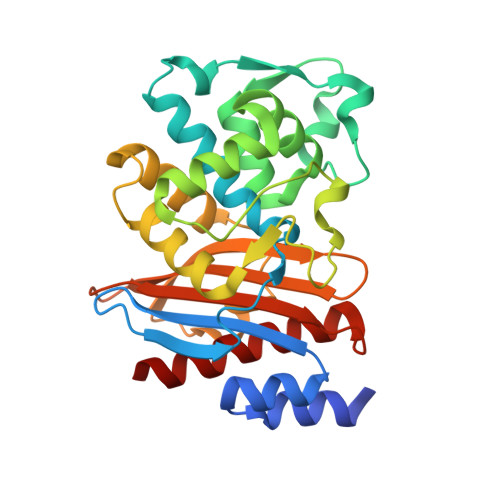Structural/mechanistic insights into the efficacy of nonclassical beta-lactamase inhibitors against extensively drug resistant Stenotrophomonas maltophilia clinical isolates.
Calvopina, K., Hinchliffe, P., Brem, J., Heesom, K.J., Johnson, S., Cain, R., Lohans, C.T., Fishwick, C.W.G., Schofield, C.J., Spencer, J., Avison, M.B.(2017) Mol Microbiol 106: 492-504
- PubMed: 28876489
- DOI: https://doi.org/10.1111/mmi.13831
- Primary Citation of Related Structures:
5NE1, 5NE2, 5NE3 - PubMed Abstract:
Clavulanic acid and avibactam are clinically deployed serine β-lactamase inhibitors, important as a defence against antibacterial resistance. Bicyclic boronates are recently discovered inhibitors of serine and some metallo β-lactamases. Here, we show that avibactam and a bicyclic boronate inhibit L2 (serine β-lactamase) but not L1 (metallo β-lactamase) from the extensively drug resistant human pathogen Stenotrophomonas maltophilia. X-ray crystallography revealed that both inhibitors bind L2 by covalent attachment to the nucleophilic serine. Both inhibitors reverse ceftazidime resistance in S. maltophilia because, unlike clavulanic acid, they do not induce L1 production. Ceftazidime/inhibitor resistant mutants hyperproduce L1, but retain aztreonam/inhibitor susceptibility because aztreonam is not an L1 substrate. Importantly, avibactam, but not the bicyclic boronate is deactivated by L1 at a low rate; the utility of avibactam might be compromised by mutations that increase this deactivation rate. These data rationalize the observed clinical efficacy of ceftazidime/avibactam plus aztreonam as combination therapy for S. maltophilia infections and confirm that aztreonam-like β-lactams plus nonclassical β-lactamase inhibitors, particularly avibactam-like and bicyclic boronate compounds, have potential for treating infections caused by this most intractable of drug resistant pathogens.
Organizational Affiliation:
School of Cellular & Molecular Medicine, University of Bristol, Bristol, UK.















